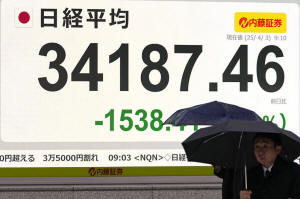Stock market today: Trump's tariff hikes pull Asian shares, US futures
sharply lower
[April 03, 2025] By
ELAINE KURTENBACH
BANGKOK (AP) — Shares tumbled in Europe and Asia and U.S. futures
tumbled Thursday following U.S. President Donald Trump ’s announcement
of big increases in tariffs on imports of goods from around the world.
The double-digit tariff hikes sent shivers across world markets, as
economists warned it raises the risk of recession.
The future for the S&P 500 dropped 3.1% while that for the Dow Jones
Industrial Average lost 2.6%, auguring potential losses when U.S.
markets reopen on Thursday.
Germany's DAX fell 1.7% to 21,998.48, while the CAC 40 in Paris lost
1.8% to 7,716.66. Britain's FTSE 100 shed 1.2% to 8,506.44.
In Asian trading, Tokyo’s Nikkei 225 index dipped 4% briefly, with
automakers and banks taking big hits. It closed down 2.8% at 34,735.93.
Mitsubishi UFJ Financial Group's shares plunged 7.2% as the potential
impact of the 24% tariffs on the export-dependent Japanese economy
dashed expectations that the central bank will keep raising interest
rates. Mizuho Financial Group skidded 8%.
Sony Corp.'s stocks sank 4.8% and Toyota Motor Corp. gave up 5.2%.
Japan's yen gained , with the U.S. dollar falling to 147.42 Japanese yen
from 149.28 yen. The euro rose to $1.0952 from $1.0855.
In South Korea, which was hit with a 25% tariff, the benchmark Kospi
fell 1.1% to 2,486.70.

Hong Kong's Hang Seng lost 1.7% to 22,813.22, while the Shanghai
Composite index edged 0.2% lower to 3,342.01.
The announcement came as a “major shock,” Yeap Junrong of IG said in a
commentary. “China, in particular, was hit with an additional 34%
tariff, bringing its total tariff burden to 64% when accounting for
previous measures.”
However, losses were partly blunted by expectations of further economic
stimulus from Beijing to offset the impact of the higher tariffs.
In Australia, the S&P/ASX 200 fell 0.9% to 7,859.70.
Bangkok's SET shed 1.1% after Thailand was assigned at 36% tariff on its
exports to the U.S. That could cause Thai exports to fall by $7 billion
to $8 billion, or about 2.3% of the total, Kasem Prunratanamala of CGS
International said in a report.
On Wednesday, U.S. stocks whipped through another dizzying day before
Trump’s unveiling of his “Liberation Day” tariffs.
[to top of second column] |

People walk past an electronic stock board showing the day's early
loss of Japan's Nikkei 225 index at a securities firm Thursday,
April 3, 2025 in Tokyo.(AP Photo/Shuji Kajiyama)
 The S&P 500 rose 0.7% to 5,670.97
after careening between an earlier loss of 1.1% and a later gain of
1.1%. It’s had a pattern this week of opening with sharp drops only
to finish the day higher.
The Dow industrials added 0.6% to 42,225.32, and the Nasdaq
composite climbed 0.9% to 17,601.05.
Financial markets around the world have broadly been shaky lately
because of uncertainty about Trump’s trade war. He has said he wants
tariffs to make the global system more fair and to bring
manufacturing jobs back to the United States from other countries.
But tariffs also threaten to grind down growth for the U.S. and
other economies, while worsening inflation when it may be stuck
above the Federal Reserve’s 2% target.
After the U.S. market closed, Trump declared a 10% baseline tax on
imports from all countries and higher tariff rates on dozens of
nations that run trade surpluses with the United States. The
president held up a chart while speaking at the White House, showing
the United States would charge a 34% tax on imports from China, a
20% tax on imports from the European Union, and 32% on Taiwan.
Trump earlier announced 25% tariffs on auto imports; levies against
China, Canada and Mexico; and expanded tariffs on steel and
aluminum. Trump has also put tariffs against countries that import
oil from Venezuela and plans separate import taxes on pharmaceutical
drugs, lumber, copper and computer chips.
Treasury yields swung in the bond market, echoing the indecision
seen in the stock market.
The yield on the 10-year Treasury fell as low as 4.11% in the
morning from 4.17% late Tuesday and from roughly 4.80% early this
year. But it later rose to 4.18%. Higher yields can indicate higher
expectations for the economy or for inflation.
In other dealings early Thursday, U.S. benchmark crude shed $2.63 to
$69.08 per barrel. Brent crude, the international standard, gave up
$2.62 to $72.33 per barrel.
All contents © copyright 2025 Associated Press. All rights reserved
 |